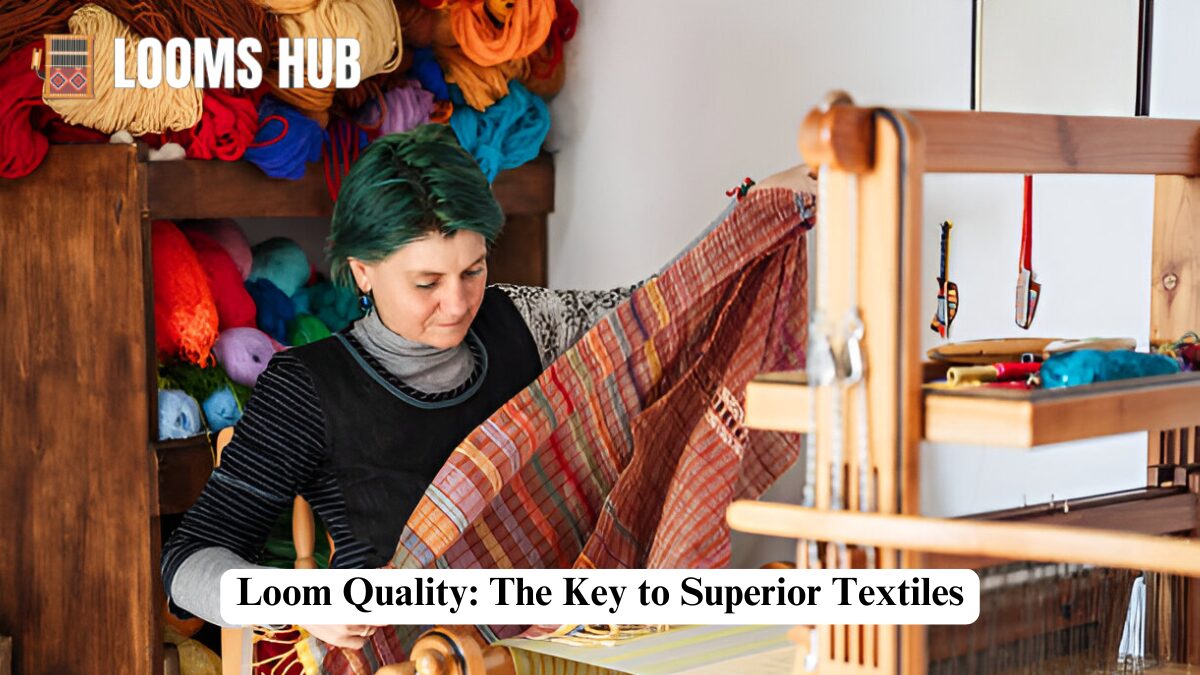Loom quality is a crucial factor in textile production, determining the durability, texture, and precision of woven fabrics. A well-constructed loom enhances efficiency, minimizes defects, and produces high-quality textiles that meet industry standards. Whether used in traditional hand-weaving or advanced automated mills, loom quality impacts every stage of fabric creation. This article explores what defines a high-quality loom, the various types available, key components, maintenance practices, and factors influencing textile outcomes.
What Defines Loom Quality?
Materials Used in Loom Construction
- High-quality looms are built from durable materials such as hardened steel, cast iron, aluminum alloys, and treated wood.
- Wooden looms, typically made from teak or maple, are preferred for traditional hand-weaving due to their flexibility and longevity.
- Industrial looms incorporate carbon fiber and reinforced composites for improved performance and longevity.
Precision and Craftsmanship in Loom Design
- The alignment of beams, gears, and heddles ensures uniform weaving.
- Poorly constructed looms result in fabric inconsistencies and thread breakage.
- High-quality looms use computerized control systems for precision adjustments.
Role of Tension Control and Stability in Weaving
- A high-quality loom maintains consistent warp thread tension to avoid loose or uneven weaves.
- Stable framework and vibration control prevent misalignment and weaving defects.
- Automatic looms adjust tension dynamically to accommodate different yarn thicknesses.
Types of Looms and Their Quality Factors
Handlooms vs. Power Looms
- Handlooms produce intricate, artisanal fabrics but require skilled craftsmanship and manual labor.
- Power looms, driven by electricity, increase speed and consistency while reducing human error.
Shuttle Looms vs. Shuttleless Looms
- Shuttle looms use a shuttle to pass the weft thread, offering versatility but slower weaving speeds.
- Shuttleless looms (e.g., rapier, air-jet, and projectile looms) operate at higher speeds with reduced wear and tear on yarns.
Specialized Looms
- Jacquard looms: Ideal for intricate patterns and designs.
- Dobby looms: Best for complex, multi-shaft weaving.
- Water-jet looms: Suited for synthetic fibers requiring moisture-based weaving.
Key Components of a High-Quality Loom
Warp Beam and Weft Insertion System
- A sturdy warp beam maintains consistent thread supply without unnecessary strain.
- Efficient weft insertion reduces thread fraying and enhances weaving precision.
Heddles and Harnesses
- High-quality heddles ensure smooth thread movement and reduce breakage.
- Multiple harnesses improve design complexity and fabric strength.
Beat-Up Mechanism and Take-Up System
- A well-calibrated beat-up system ensures uniformity in fabric density.
- Advanced take-up rollers prevent loose or tight fabric tension.
Factors Affecting Loom Performance and Quality
Loom Speed and Efficiency
- High-speed looms (500-2000 RPM) improve production but require precise synchronization.
- Air-jet and rapier looms balance speed and energy efficiency.
Fabric Type and Thread Count
- Silk and delicate fibers demand fine-tuned looms with minimal tension fluctuations.
- Denser fabrics require reinforced loom components to handle higher warp tension.
Automation and Digital Control Systems
- Modern looms integrate AI-driven sensors for automatic error detection.
- Programmable logic controllers (PLCs) allow real-time adjustments.
Maintenance and Care for Loom Longevity
Routine Inspections and Lubrication
- Regular bearing lubrication prevents friction damage.
- Alignment checks reduce unnecessary fabric waste.
Cleaning and Thread Management
- Removing dust, lint, and residue extends the loom’s lifespan.
- Proper warp and weft alignment prevents thread entanglement issues.
Upgrading and Retrofitting
- Older looms benefit from retrofitted electronic controls and tension management systems.
- Upgrading mechanical looms to hybrid models improves efficiency.
Case Studies: Loom Quality in Textile Production
Case Study 1: Handloom Weaving in India
- Traditional handlooms in Varanasi produce world-famous Banarasi silk.
- Skilled artisans maintain looms passed down through generations.
Case Study 2: European Power Loom Innovations
- German textile firms use high-speed rapier looms for precision weaving.
- Automated defect detection minimizes fabric inconsistencies.
Case Study 3: Sustainability in Loom Design
- Scandinavian manufacturers develop eco-friendly looms using sustainable materials.
- Water-efficient jet looms reduce environmental impact.
Comparison Table: Handloom vs. Power Loom
| Feature | Handloom | Power Loom |
| Speed | Slow | Fast |
| Fabric Complexity | High (intricate designs) | Moderate to high |
| Energy Usage | Manual (zero electricity) | Requires electricity |
| Maintenance | Low | Moderate to high |
| Skill Required | High | Moderate |
Conclusion
Loom quality directly influences textile strength, design, and production efficiency. Whether using traditional handlooms or advanced automated models, investing in high-quality looms ensures superior fabric output. Proper maintenance and technological upgrades further enhance loom performance, making them essential assets in the textile industry. Understanding loom quality helps manufacturers and artisans produce exceptional textiles that meet both artistic and industrial standards.
FAQs
What makes a high-quality loom?
A loom’s quality is determined by its materials, precision in construction, and ability to maintain consistent tension and stability.
How does loom quality impact textile durability?
A high-quality loom ensures proper thread interlacing, reducing weak points and enhancing fabric strength.
Which is better: handloom or power loom?
Handlooms excel in artistry and uniqueness, while power looms provide higher production efficiency and consistency.
What are the common issues in low-quality looms?
Frequent thread breakage, uneven tension, misaligned components, and excessive vibration.
How often should a loom be maintained?
Routine maintenance, including lubrication and alignment checks, should be done monthly for optimal performance.
What type of loom is best for intricate patterns?
Jacquard looms are ideal for detailed and complex woven designs.
Can an old loom be upgraded?
Yes, retrofitting with electronic controls and advanced tension systems can improve efficiency.
What role do automation and AI play in modern looms?
They enhance precision, reduce human error, and increase efficiency through real-time adjustments.
Why do some fabrics require specialized looms?
Delicate materials like silk need controlled tension, while heavy fabrics require reinforced frames.
How does loom quality impact sustainability?
Efficient looms reduce waste, use less energy, and support sustainable textile manufacturing.



